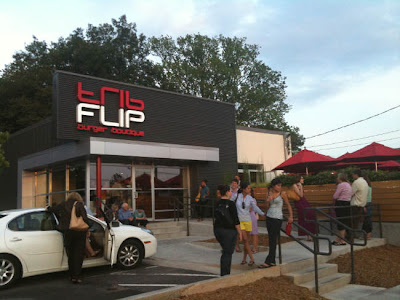Ten burgers to eat before you die? It sounds maybe a bit too dramatic, or even pathetic, or, you know, you can say this of Naples (the famous Italian saying,
vedi Napoli e poi mori), not necessarily about burgers. And after all, you shouldn't die after eating ten burgers; rather live further and keep on eating.
I found the other day an article on the
web about the
top ten US burger joints. Actually it's about ten places where you can find such stuff: ten places all over America, from coast to coast. A tavern in the City of Winds near the Great Lakes, a shack in Madison Square Park in Manhattan, a bar in Las Vegas, a
bite or something in Santa Fe, a boutique in Atlanta, a drive in in Brentwood (to see what Missouri can show us), a burger house in L.A., another one in San Francisco, a great place in Dallas, and a
tub (yes, that's it) in Hollywood (only it's the Hollywood in Florida).
1.
Billy Goat Tavern (Chicago, IL)

A goat entered once in the tavern and remained there as a permanent patron. The owner of the place (a Mr. Sianis) took such a liking for the animal that he made it part of the family.
This Mr. Sianis was kind of a fellow: according to
Mike Royko (the famous, or rather infamous, Chicago columnist), he was
the best tavern keeper in town.
Well, Mr. Sianis (who by now was known as
Billy Goat Sianis) was a
Chicago Cubs fan, so he decided to buy two tickets for the game and to take the goat with a limo to the stadium. The ushers didn't allow them to pass the gates. Mr. Sianis appealed to the owner of the Cubs, who knew him well. But even the owner was firm:
the goat stinks! Mr. Sianis was so upset that he put a curse on the club, to not win any more,
never,
nada, and the curse worked! The Cubs became for years
The Lovable Losers, and
Billy Goat Sianis had now good reasons to ask the club owner:
well, who stinks now?
You see, the world of baseball is full of such legends, and so is Billy Goat Tavern!
2.
Shake Shack (New York, NY)

I 've never been in Chicago, so I'm excused to never visit
Billy Goat Tavern, but there is no reason I didn't go yet to
Shake Shack: it's in
Madison Square Park and I passed by many times. The restaurateur owns also another two eateries, not far from this place (
Gramercy Tavern and
Union Square Café). Speaking about Gramercy, I was once at
Gramercy Theater, invited to a very special screening:
Jack Goelman was presenting some very old footage, French and American documentaries from between the world wars. But this is another story and it deserves a post of its own.
3.
Burger Bar (Las Vegas, NV)

The bar is run by the same person who runs
Fleur de Lys, a notable restaurant there in Las Vegas.
Says the
article I found on the
web,
the pièce de résistance is the pricey Rossini burger made from Kobe beef, sautéed foie gras, shaved truffles and Madeira sauce on an onion bun, and it continues,
shakes and floats plus an extensive selection of bottled and draft beers and a small but first-rate wine list nicely complement the cuisine. I asked a friend who recently was in Las Vegas; he visited the place and said to me that's true, beef, foie gras and all that stuff.
4.
Bobcat Bite (Santa Fe, NM)

After Nevada, New Mexico.
Bobcat Bite: it used to be a trade post in the old times. Well, times have changed and we are now aware of cholesterol and stuff, but at
Bobcat Bite they keep on the same old recipe for burgers.
5.
FLIP Burger Boutique (Atlanta, GA)

They claim to have 30 varieties of burgers at FLIP, though I wouldn't recommend to check the whole enchilada. I had today a medical appointment and I was told that my cholesterol raised in the last two months, so you will understand my caution.
6.
Carl's Drive In (Brentwood, MO)

The secret to a great burger is getting it from the grill to the customer as fast as possible, this is what I found out once: I was passing by a
Dixie store in Georgetown (the famous neighborhood in Washington, DC) and there was a festival of alcohol and burgers there. By that time I didn't know that such a secret had come from Missouri. I learned it at
Carl's in Brentwood.
7.
25 Degrees (Los Angeles, CA)

It's just a burger, nothing more :)

8.
BurgerMeister (San Francisco, CA)

A friend of mine offered his wife a trip to San Francisco: it was the fifteenth anniversary of their marriage and they wanted to do it in style. So
BurgerMeister was not on their list. It happened though that they discovered some old neighborhoods with their special charm, and
BurgerMeister was there. It's from them that I learned about the place.
9.
Chip's Old Fashioned Hamburgers (Dallas, TX)

I was in Dallas and it's a shame I did not know about this place: the exterior is maybe kind of conventional, but inside it looks like all those good old Texan shacks look.

10.
Le Tub (Hollywood, FL)

A great venue: you can come by boat, buy your burger and then enjoy it on your deck.
It used to be a gas station here, long time ago. The present owner bought the barren space and created a garden decorated with all kind of sea stuff gathered by him in four years of beach jogging.
 (Blogosphere)
(Blogosphere)






























